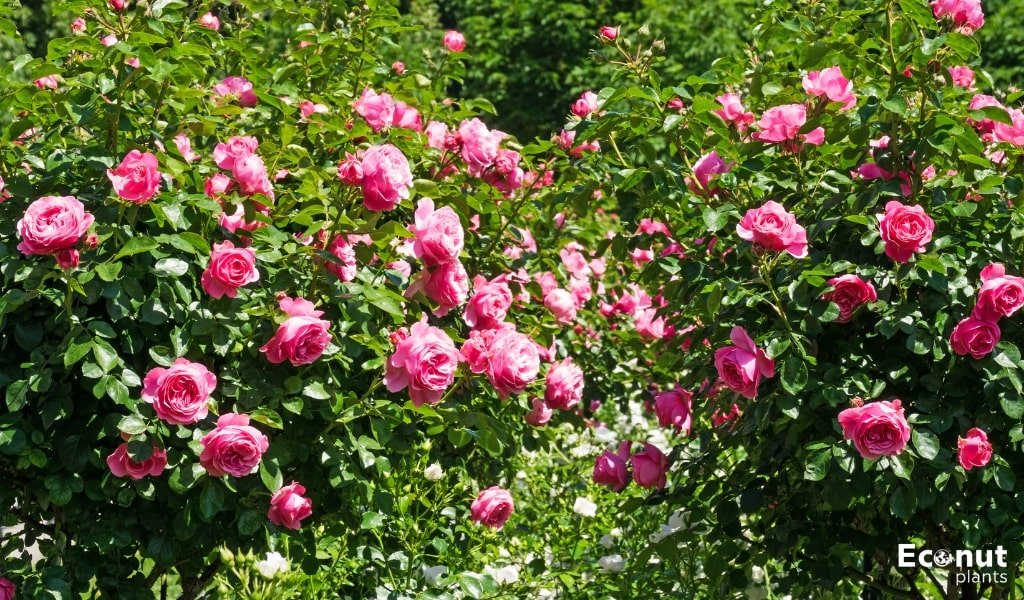The stunning blooms of a rose shrub outweigh the foliage. However, fading rose leaves can harm your plant’s general health as well as diminish the appearance of the blossoms.
In late fall, if you see leaves turning yellow, this is probably a normal part of the plant’s life cycle. Additionally, older leaves may turn yellow and fall off, making way for new growth.
However, if leaves turn yellow throughout the growth season, there may be a fixable issue that may be addressed before further harm is done. Take a look at eight of the most typical causes of yellowing rose leaves and learn how to prevent or treat them.
1. Over shading
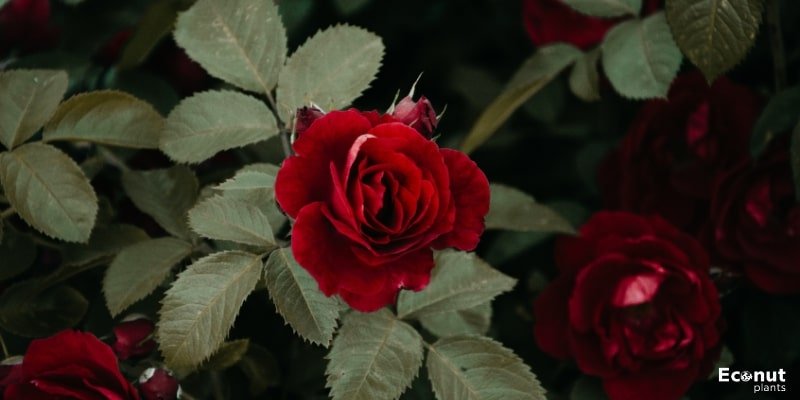 Most roses need six to eight hours of direct sunlight per day to thrive and produce lush, green leaves. If your plant’s leaves are shaded by the canopy of nearby plants, they could become yellow.
Most roses need six to eight hours of direct sunlight per day to thrive and produce lush, green leaves. If your plant’s leaves are shaded by the canopy of nearby plants, they could become yellow.
On rose shrubs, the dense foliage at the top can occasionally obscure the inner and lower leaves, causing the leaves to finally turn yellow and fall off.
The Fix
After determining what’s blocking the sun’s light, trim any surrounding plants as needed. To increase the amount of light and ventilation inside the rose bush, take out your pruners and trim back any overly dense growth. When the rose is still dormant in the early spring, move it if you feel it needs to be in a more sunny position.
2. Too Much Water
 Roses enjoy being fully dry in between watering. Overwatering can cause the roots to decay and get wet. As a result, the plant as a whole becomes weaker and droops because the roots are unable to absorb nutrients and oxygen.
Roses enjoy being fully dry in between watering. Overwatering can cause the roots to decay and get wet. As a result, the plant as a whole becomes weaker and droops because the roots are unable to absorb nutrients and oxygen.
Your plant is probably wilting if the soil is wet. It’s also possible that you’ll notice leaves falling off the plant and becoming yellow. Rain and poor drainage can occasionally result in soggy soil and yellowing foliage. To allow for some air in this situation, you will need to slightly amend your soil.
The Fix
Water sparingly and deeply. Once a week, mature roses require two to four liters of water. Insert your fingers a little bit into the earth before watering. Wait to water if the top one to two inches are still wet.
Even if excessive rainfall isn’t an issue, you can still be of assistance by enhancing soil drainage. Add three to four inches of organic compost, leaf mould, shredded bark, or aged manure to the soil to improve it.
All of them will allow your rose to breathe again by increasing the number of air pockets and circulation in damp, compacted soil!
3. Drought Conditions
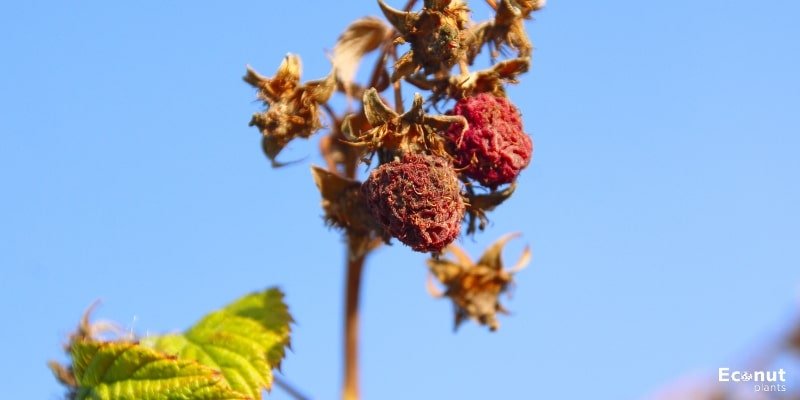 There might not be enough water to solve the issue! Roses can wilt as a whole and turn yellow when they are underwater or suffer drought. For roses to remain healthy and in bloom, they require deep weekly watering from you or the rain.
There might not be enough water to solve the issue! Roses can wilt as a whole and turn yellow when they are underwater or suffer drought. For roses to remain healthy and in bloom, they require deep weekly watering from you or the rain.
The problem is made worse by dry winds that deprive the soil and plants of essential moisture in areas where your rose is exposed to them.
Yellow leaves with brown edges frequently show signs of drought degradation. Potted plants are particularly vulnerable since they dry out more quickly.
The Fix
Try watering your roses twice a week under drought conditions to see if they start to bloom again. For ten to fifteen minutes, leave the hose at the base of the plant to ensure a thorough, deep soak.
Mulch is the best way to keep moisture in plants during a drought, regardless of type. Spread a thick layer of compost, leaf mould, or cedar wood mulch around the base of your plants. By preventing water evaporation and runoff, the mulch will keep your roses healthy and hydrated!
4. Heat Stress

If you don’t give your roses the right care over the winter, they may suffer damage from the cold. Conversely, during the summer months, excessive heat might result in an entirely separate set of issues.
Roses love the light, but they become irritable in temperatures above 85 degrees Fahrenheit, particularly after being transplanted. Small flower sizes, drooping plants, and yellow leaves with brown tips are all signs of excessive heat.
Different rose cultivars are more or less heat-tolerant. Make sure the rose you purchase is suitable for your hardiness zone before making a purchase.
The Fix
Choose a spot that receives morning sun and some afternoon shade if you want to keep your roses cooler in hotter climes. In the warmest portion of the day, this will shield them from sunburn and overheating.
If there’s no place where you can find afternoon shade, you can choose to cover them during the warmest part of the day using a shade cloth or an umbrella. To ensure that your plants receive enough sunshine and ventilation in the morning, remember to remove the cover in the evening.
To maintain cool and shaded roots, mulch your plants with a layer of wood chips or compost. Adding mulch to the soil helps it retain moisture and become more resilient to heat.
5. Foliar Diseases
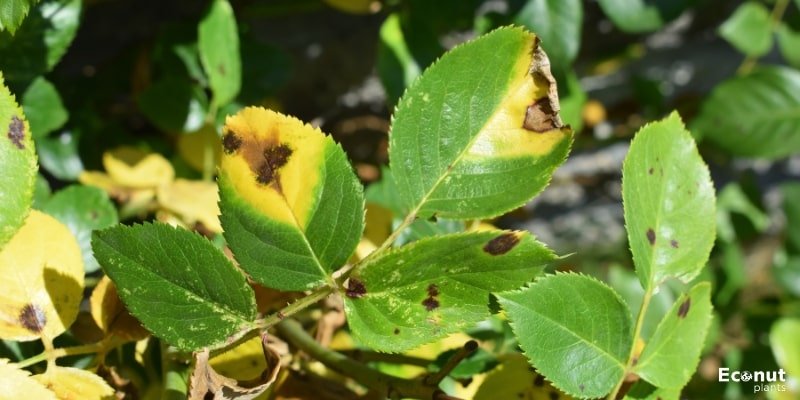
A foliar disease may be to blame if you notice leaves with erratic yellow splotches and patterns. Yellow leaves that fall off the plant are caused by two prevalent rose diseases: rose mosaic and black spot.
On the leaves, black spots resemble asymmetrical black or brown splotches with yellow haloes around them. It typically starts on the shrub’s lower leaves and moves upward.
Rusty brown patches will appear on canes infected with black spots if treatment is not received. It travels from one plant to another through the water, wind, and contaminated leaves.
Also Read: Roses Holes Leaves
The Fix
Rose mosaic and black spots have no known cures. But that doesn’t imply that your rose has to die. The aim of treating a black spot is to stop its spread. Eliminate all diseased foliage.
Water the plant from the base instead of the leaves to avoid the moist circumstances that promote the growth of spores. To allow them to dry out in between watering, make sure there is enough ventilation and sunlight.
You can live with a rose mosaic, and it won’t spread to your other plants. However, it’s better to remove and replace the plant if your rose is no longer blooming or is only producing malformed buds.
6. Nutrient Deficiency
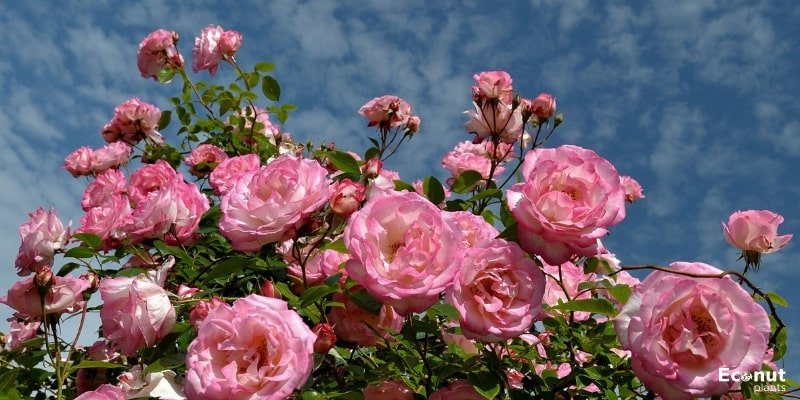 Iron and nitrogen deficiencies in the soil are common causes of rose foliage yellowing. When leaves are pale yellow but the veins are still green, there is likely an iron deficit. We call this yellowing of the leaves chlorosis.
Iron and nitrogen deficiencies in the soil are common causes of rose foliage yellowing. When leaves are pale yellow but the veins are still green, there is likely an iron deficit. We call this yellowing of the leaves chlorosis.
An iron deficiency or excessively alkaline soil could be the cause of the issue. Rose roots cannot get the iron they require from the soil when the pH of the soil is higher than 6.5.
Uniform, light yellow-green leaves that climb from the bottom are a sign of a nitrogen deficit. The roots of roses cannot obtain the necessary nitrogen when the soil has a pH of less than 6.
The Fix
Soil testing with a basic kit is the most reliable technique to determine what you have on hand. Applying a liquid chelated iron solution to the soil can help address the iron shortage. Applying a lime product will increase the soil’s alkalinity if it is excessively acidic.
Think about incorporating some blood meal or your morning coffee grounds into the soil if you just need to apply nitrogen. They both provide an increase in nitrogen and support the development of blooms.
Also Read: Desert Rose Plant
7. Too Much Fertilizer
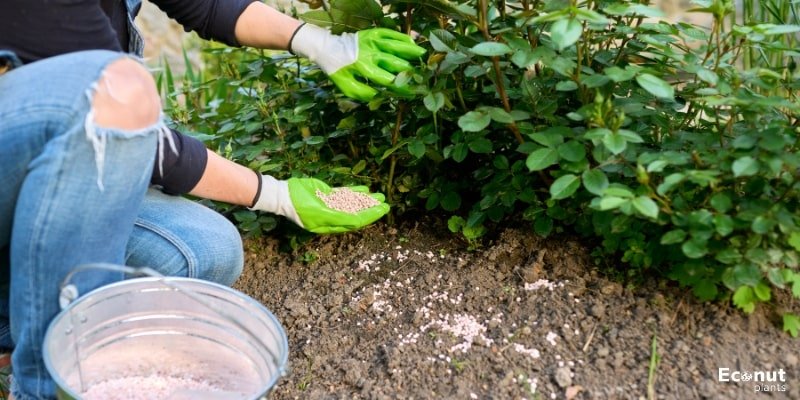
If you want to fertilize your roses heavily and hope for the best, proceed with caution. Specifically, young roses may be harmed by excessive fertilizer, which can result in leaf yellowing.
Over-fertilizing might destroy beneficial bacteria in the soil that are essential to the health of your roses. This is especially the case with synthetic fertilizers. Brown or yellow leaves and stunted development can be the result of over-fertilizing with nitrogen fertilizer, which can burn the roots.
The Fix
Freshly planted roses should never be fertilized. Let their root systems grow first to avoid root burns. When possible, replace synthetic fertilizers with organic ones such as compost, manure, prepared Lucerne, and seaweed-based products to preserve the health of your soil.
Fertilize your plants before the last fall flush, in midsummer, and before your roses leaf out for the first time in the spring. If your soil is healthy, it should be all you need!
8. Spider Mites
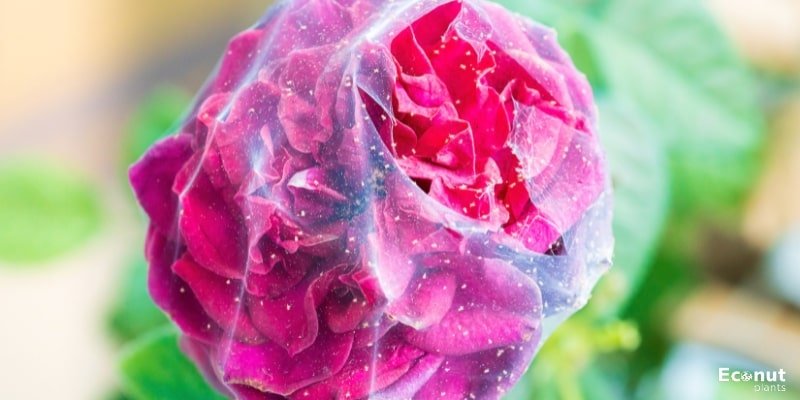 Spider mites are tiny, bothersome, and hard-to-identify insects. Typically, they favour hot, dry conditions. Their leaves turn golden and bronze in colour.
Spider mites are tiny, bothersome, and hard-to-identify insects. Typically, they favour hot, dry conditions. Their leaves turn golden and bronze in colour.
On parched, heat-stressed plants, spider mites thrive. Turn your leaves over and inspect the undersides if you suspect you may have spider mites.
The Fix
The most effective method of combating spider mites is to hand-remove them using a powerful hose spray. Don’t forget to strike the leaf undersides!
Maintaining proper hydration for your plants will help keep them away. Research suggests that if leaves are removed, they can be avoided by spraying them every morning with cold water.
Try to ignore the invasion of spider mites and let their predators take care of them while you try to hose them off as much as you can. It could take a few weeks for this.
9. Herbicide Damage
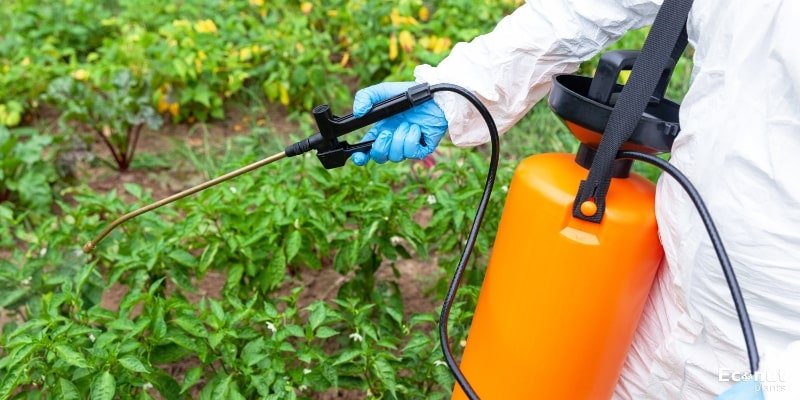 It’s possible that pesticide damage caused the abnormally small, yellow, and atypically shaped new leaves on your rose. Deformed buds and twisted leaves are further indications.
It’s possible that pesticide damage caused the abnormally small, yellow, and atypically shaped new leaves on your rose. Deformed buds and twisted leaves are further indications.
The culprits are probably broad-leaf herbicides like weed and feed that are regularly sprayed on lawns or products like Roundup that include glyphosate. If these weed killers happen to drift over your roses during a breeze, they could damage them irreversibly.
If you’ve never employed a weed-killing chemical, it’s possible that your garden’s boundaries were crossed by a neighbour’s spray.
Also Read: Toxic Plants Dangerous Human Health
The Fix
Some roses will perish if exposed to herbicides. Certain individuals heal more slowly. All you have to do is observe. Fertilize them only once they start growing regularly, as this may cause further stress.
Meanwhile, make sure you are giving your rose enough water. It could have had a bad season and then done quite well the next year. To prevent herbicide damage, don’t use any products in your garden that include glyphosate.
Remove weeds by hand from around the roses. Make use of mulch and eye-catching groundcovers to prevent the growth of weeds. Weed killers can affect roses as well, so keep them away from them.
If you choose to use chemical weed control, proceed with extreme caution to safeguard your roses, children, pets, and animals.
Conclusion
Generally speaking, yellow leaves indicate that something is off with your roses. You can identify the offender and choose the most effective course of action to get them back on track with a little detective work.
Recall that roses require sufficient airflow, deep, infrequent watering, rich, organic soil, and sunlight. Your roses will grow strong and healthy if you provide these components along with a balanced approach to managing weeds and pests!

